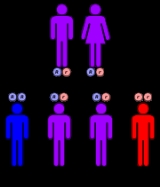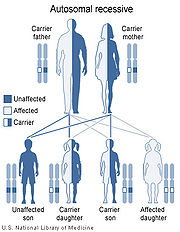
Netherton syndrome
Encyclopedia
Netherton syndrome is a severe, autosomal
recessive form of ichthyosis
associated with mutations in the SPINK5
gene. It is named after E.W. Netherton.
and allergy
, leading to the development of scaly, reddish skin similar to atopic dermatitis
. In severe cases, these atopic manifestations persist throughout the individual's life, and consequently post-natal mortality rates are high. In less severe cases, this develops into the milder ichthyosis linearis circumflexa
.
Allergies to nuts and fish are also common amongst affected people but they are not always present in every case.
 Netherton syndrome is an autosomal recessive
Netherton syndrome is an autosomal recessive
disorder associated with mutations in the SPINK5 gene, which encodes the serine protease
inhibitor lympho-epithelial Kazal-type-related inhibitor (LEKTI). These mutations result in a dysfunctional protein that has a reduced capacity to inhibit serine proteases expressed in the skin. Potential endogenous targets of LEKTI include KLK5
, KLK7
and KLK14
. These enzymes are involved in various aspects of epidermal remodelling, including desquamation
, PAR-2 activation and degradation of lipid hydrolases, suggesting a potential mechanism for the development of atopic manifestations characteristic of Netherton syndrome.
Disease severity is determined by the level of LEKTI expression and, consequently, serine protease activity. Complete SPINK5 gene deletions have been linked to severe cases, while mutations which induce alternate splicing or create premature stop codons may lead to varying levels of severity. Furthermore, LEKTI-knockout mice exhibit a phenotype similar to Netherton syndrome in humans.
Steroid and retinoid products have been proven ineffective against Netherton syndrome and may in fact make things worse for the affected individual.
Autosome
An autosome is a chromosome that is not a sex chromosome, or allosome; that is to say, there is an equal number of copies of the chromosome in males and females. For example, in humans, there are 22 pairs of autosomes. In addition to autosomes, there are sex chromosomes, to be specific: X and Y...
recessive form of ichthyosis
Ichthyosis
Ichthyosis is a heterogeneous family of at least 28, generalized, mostly genetic skin disorders. All types of ichthyosis have dry, thickened, scaly or flaky skin...
associated with mutations in the SPINK5
SPINK5
Lympho-epithelial Kazal-type-related inhibitor also known as serine protease inhibitor Kazal-type 5 is a protein that in humans is encoded by the SPINK5 gene.- Structure and function :...
gene. It is named after E.W. Netherton.
Characteristics
Netherton syndrome is characterised by chronic skin inflammation, universal pruritus (itch), severe dehydration and stunted growth. Patients with this disorder tend to have a hair shaft defect (trichorrhexis invaginata), also known as "bamboo hair". The disrupted skin barrier function in affected individuals also presents a high susceptibility to infectionInfection
An infection is the colonization of a host organism by parasite species. Infecting parasites seek to use the host's resources to reproduce, often resulting in disease...
and allergy
Allergy
An Allergy is a hypersensitivity disorder of the immune system. Allergic reactions occur when a person's immune system reacts to normally harmless substances in the environment. A substance that causes a reaction is called an allergen. These reactions are acquired, predictable, and rapid...
, leading to the development of scaly, reddish skin similar to atopic dermatitis
Atopic dermatitis
Atopic dermatitis is an inflammatory, chronically relapsing, non-contagious and pruritic skin disorder...
. In severe cases, these atopic manifestations persist throughout the individual's life, and consequently post-natal mortality rates are high. In less severe cases, this develops into the milder ichthyosis linearis circumflexa
Ichthyosis linearis circumflexa
Ichthyosis linearis circumflexa is a distinctive skin condition of generalized hyperkeratosis and polycyclic and serpiginous erythematous plaques with a characteristic, migratory, double-edged scale at the margins, and is the typical cutaneous manifestation of Netherton's syndrome....
.
Allergies to nuts and fish are also common amongst affected people but they are not always present in every case.
Cause and Genetics

Recessive
In genetics, the term "recessive gene" refers to an allele that causes a phenotype that is only seen in a homozygous genotype and never in a heterozygous genotype. Every person has two copies of every gene on autosomal chromosomes, one from mother and one from father...
disorder associated with mutations in the SPINK5 gene, which encodes the serine protease
Serine protease
Serine proteases are enzymes that cleave peptide bonds in proteins, in which serine serves as the nucleophilic amino acid at the active site.They are found ubiquitously in both eukaryotes and prokaryotes...
inhibitor lympho-epithelial Kazal-type-related inhibitor (LEKTI). These mutations result in a dysfunctional protein that has a reduced capacity to inhibit serine proteases expressed in the skin. Potential endogenous targets of LEKTI include KLK5
KLK5
Kallikrein-related peptidase 5 , formerly known as stratum corneum tryptic enzyme , is a serine protease expressed in the epidermis. In humans it is encoded by the KLK5 gene. This gene is one of the fifteen kallikrein subfamily members located in a cluster on chromosome 19. Its expression is...
, KLK7
KLK7
Kallikrein-related peptidase 7 is a serine protease that in humans is encoded by the KLK7 gene. KLK7 was initially purified from the epidermis and characterised as stratum corneum chymotryptic enzyme...
and KLK14
KLK14
Kallikrein-14 is a protein that in humans is encoded by the KLK14 gene.-External Links:* The MEROPS online database for peptidases and their inhibitors:...
. These enzymes are involved in various aspects of epidermal remodelling, including desquamation
Desquamation
Desquamation , also called skin peeling, is the shedding of the outermost membrane or layer of a tissue, such as the skin.-Skin:Normal, nonpathologic desquamation of the skin occurs when keratinocytes, after moving apically over about 14 days, are individually shed unnoticeably...
, PAR-2 activation and degradation of lipid hydrolases, suggesting a potential mechanism for the development of atopic manifestations characteristic of Netherton syndrome.
Disease severity is determined by the level of LEKTI expression and, consequently, serine protease activity. Complete SPINK5 gene deletions have been linked to severe cases, while mutations which induce alternate splicing or create premature stop codons may lead to varying levels of severity. Furthermore, LEKTI-knockout mice exhibit a phenotype similar to Netherton syndrome in humans.
Treatment
There is no known cure at the moment but there are several things that can be done to relieve the symptoms. moisturising products are very helpful to minimise the scaling/cracking and anti-infective treatments are useful when appropriate because the skin is very susceptible to infection. Extra protein in the diet during childhood is also beneficial to replace that which is lost through the previously mentioned "leaky" skin.Steroid and retinoid products have been proven ineffective against Netherton syndrome and may in fact make things worse for the affected individual.

